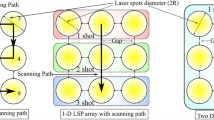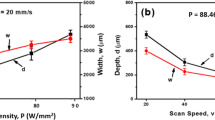Abstract
This study explores the laser-arc hybrid welding process of high nitrogen steel (HNS) in order to circumvent the problem of welding porosity. The influence of welding heat input on welding porosity has been elucidated by analyzing the changes in the morphological characteristics of the laser keyhole and the molten pool temperature. The results show that the pore ratio increases with a rise in laser power. Meanwhile, the pore ratio first decreases and then increases as the welding current intensifies. Additionally, it decreases as the welding speed and defocus amount increase. The lowest pore ratio of the weld is considered as the desired value, and the response surface method (RSM) is used to optimize the heat input parameters. When the laser power ranges from 2.80 to 2.85 kW, the welding current becomes 260 A, welding speed ranges from 0.73 to 0.80 m/min, defocus amount ranges from 0 to 1 mm, and pore ratio of the weld exhibits its minimum value (4.29 to 4.67%).















Similar content being viewed by others
References
Speidel MO (2006) Nitrogen containing austenitic stainless steels. Materialwissenschaft Und Werkstofftechnik 37(10):875–880
Lang YP QU H-p, CHEN H-t, WENG Y-q Research progress and development tendency of nitrogen-alloyed austenitic stainless steels. J Iron Steel Res (International) 22(2):91–98
Berns Hans High Nitrogen Steels. Manufacture and application of high nitrogen steels. ISIJ Int 36(7):909–914
Uggowitzer PJ, Magdowski R, Speidel MO (1996) Nickel free high nitrogen austenitic steels. ISIJ Int 36(7):901–908
Sumita M, Hanawa T, Teoh S (2004) Development of nitrogen-containing nickel-free austenitic stainless steels for metallic biomaterials. Mater Sci Eng: C 24(6-8):753–760
Zhao L, Tian Z-l, Peng Y, Qi Y-c, Wang Y-j (2007) Influence of nitrogen and heat input on weld metal of gas tungsten arc welded high nitrogen steel. J Steel Res Int 14 (5)
Iamboliev T, Zumbilev A, Christov S, Kalev L, Ianev V, Stang R (1999) Laser beam welding of high-nitrogen-containing austenitic stainless steel. Welding J 78 (7)
Lin Z, Zhiling T, Yun P (2007) Porosity and nitrogen content of weld metal in laser welding of high nitrogen austenitic stainless steel. Isij Int
Liu S, Liu F, Hong Z, Yan S (2012) Analysis of droplet transfer mode and forming process of weld bead in CO2 laser-MAG hybrid welding process. Optics Laser Technol 44(4):1019–1025
Liu S, Li Y, Liu F, Zhang H, Ding H (2016) Effects of relative positioning of energy sources on weld integrity for hybrid laser arc welding. Optics Lasers Eng 81:87–96
Zhang C, Gao M, Wang D, Yin J, Zeng X (2017) Relationship between pool characteristic and weld porosity in laser arc hybrid welding of AA6082 aluminum alloy. J Mater Process Tech 240:217–222
Zhang F, Liu S, Liu F, Zhang H (2019) Stability evaluation of laser-MAG hybrid welding process. Optics Laser Technol 116:284–292
Liu S, Zhang F, Dong S, Zhang H, Liu F (2018) Characteristics analysis of droplet transfer in laser-MAG hybrid welding process. Int J Heat Mass Transfer 121(jun.):805–811
Yunfei M, Ming G, Xiaoyan Z (2018) Effects of arc types on the laser-arc synergic effects of hybrid welding. Optics Express 26(11):14775
Fengde L, Xingran L, Youzhi L, Shuangyu L, Hong Z, Xinxin L, Hongwei L (2019) Study of the microstructure and impact properties of the heat-affected zone of high nitrogen steel for laser-arc hybrid welding. Mater Res Express 6(7):076505
Li X, Zhang H (2018) Analysis of microstructure and properties of welded joint of high nitrogen steel by hybrid welding. Mater Res Express
Bai D, Li Y, Liu F, Zhang H, Yang L (2019) Study on corrosion behavior of high-nitrogen steel laser-arc hybrid welding joints in different heat source action area. Mater Res Express 6(10):106573
Ji-Qiang S, Huang G-Z, Zhang J-J, Jin-Gang W, Dan-Dan H, Zhang H (2016) Microstructural evolution and hardness profile of high nitrogen austenitic steel after arc-laser hybrid welding. DEStech Transact Eng Technol Res (mdm)
Satir-Kolorz AH, Feichtinger HK (1991) On the solubility of nitrogen in liquid iron and steel alloys using elevated pressure. Zeitschrift fur Metallkunde(Germany) 82(9):689–697
Chipman JCDA (1965) Prediction of the solubility of nitrogen in molten steel. Trans Met Soc AIME 233:1249–1252
Menzel J, Kirschner W, Stein G (1996) High nitrogen containing Ni-free austenitic steels for medical applications. ISIJ Int 36(7):893–900
Satir-Kolorz AH, Feichtinger HK (1991) On the solubility of nitrogen in liquide iron and steel alloys using elevated pressure. Z Metalkunde 82(9):689–697
Golubev VS (1996) Possible models of hydrodynamic nonstationary phenomena in the processes of laser beam deep penetration into materials. 219-230
Dongxia Y, Xiaoyan L, Dingyong H, Zuoren N, Hui H (2012) Optimization of weld bead geometry in laser welding with filler wire process using Taguchi's approach. Optics Laser Technol 44(7):2020–2025
Ragavendran M, Chandrasekhar N, Ravikumar R, Saxena R, Vasudevan M, Bhaduri AK (2017) Optimization of hybrid laser – TIG welding of 316LN steel using response surface methodology (RSM). Optics Lasers Eng 94(JUL.):27–36
Ragavendran M, Chandrasekhar N, Ravikumar R, Saxena R, Vasudevan M, Bhaduri A (2017) Optimization of hybrid laser–TIG welding of 316LN steel using response surface methodology (RSM). Optics Lasers Eng 94:27–36
Liu J (2011) Technology optimizing research on laser nonpenetration lap welding of stainless steel based on design-expert V7. J Mech Eng 16:52–60
Data availability
All data generated or analyzed during this study are included in this published article.
Code availability
Not applicable.
Funding
This research was supported by a grant from the Horizontal Subject (20210046).
Author information
Authors and Affiliations
Contributions
Shuangyu Liu contributed to the conception of the study. Fulong Zhang performed the experiment. Tianwen Luo and Mingjia Feng contributed to analysis and manuscript preparation.
Corresponding author
Ethics declarations
Ethics approval
Not applicable.
Consent to participate
Not applicable.
Consent for publication
Not applicable.
Conflict of interest
The authors declare no competing interests.
Additional information
Publisher’s note
Springer Nature remains neutral with regard to jurisdictional claims in published maps and institutional affiliations.
Rights and permissions
About this article
Cite this article
Cui, B., Liu, S., Zhang, F. et al. Effect of welding heat input on pores in laser-arc hybrid welding of high nitrogen steel. Int J Adv Manuf Technol 119, 421–434 (2022). https://doi.org/10.1007/s00170-021-08113-z
Received:
Accepted:
Published:
Issue Date:
DOI: https://doi.org/10.1007/s00170-021-08113-z




